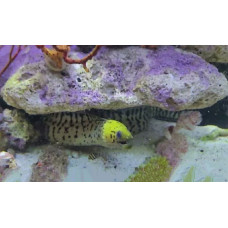Latin name
Gymnothorax fimbriatus
Other name
Dark-spotted moray or spot-face moray.
Identification
Fimbriated moray eels have a serpentine body and a pointed head. They have between 128 and 142 vertebrae.
Features of fish fins
The dorsal fin runs along the back just behind the head and merges seamlessly with the caudal and anal fins.
Fish colouring
These fish have a white/cream to tan colouration with numerous black spots which vary in size and shape depending on the individual and maturity. The snout is greenish-yellow with black spots and the corners of the mouth are white.
Distribution
Widespread in tropical waters of the Indo-Pacific region, mainly on the coastal reefs of oceanic islands from Madagascar to Polynesia and from southern Japan to New Caledonia.
Habitat
Marine, preferring brackish waters. Depths from 0 to 50 m. Occurs in sheltered areas on the outer slopes of coral reefs, on upper reefs, in lagoons and harbours.
Size
The fimbriated moray is a medium-sized moray. Maximum length is 93.4 cm for males and 87.2 cm for females. Maximum weight: 1.5 kg.
Behavior
Prefers sheltered coastal waters among dead coral, often found in harbours and small caves. Probably nocturnal, hiding during the day in crevices 1 to 50 metres deep.
Food and feeding habits
Carnivorous, they leave their burrow at night to actively hunt their prey along the reef. They feed mainly on small fish and crustaceans.
Reproduction
Possibly a protogynous hermaphrodite.
Fishing
The species is of negligible commercial interest in fisheries.
Relationship with a person
Harmless.
| Classification | |
| Phylum | Chordata |
| Class | Actinopterygii |
| Squad | Anguilliformes |
| Family | Muraenidae |
| Genus | Gymnothorax |
| Species | G. fimbriatus |
| Features | |
| Conservation status | Least Concern |
| Habitat | Pelagic |
| Life span, years | No information |
| Maximum body weight, kg | 1,5 |
| Maximum length, cm | 93,4 |
| Sailing speed, m/s | No information |
| Threat to people | Not edible |
| Way of eating | Predator |
Fimbriated moray
Tags: fimbriated moray


